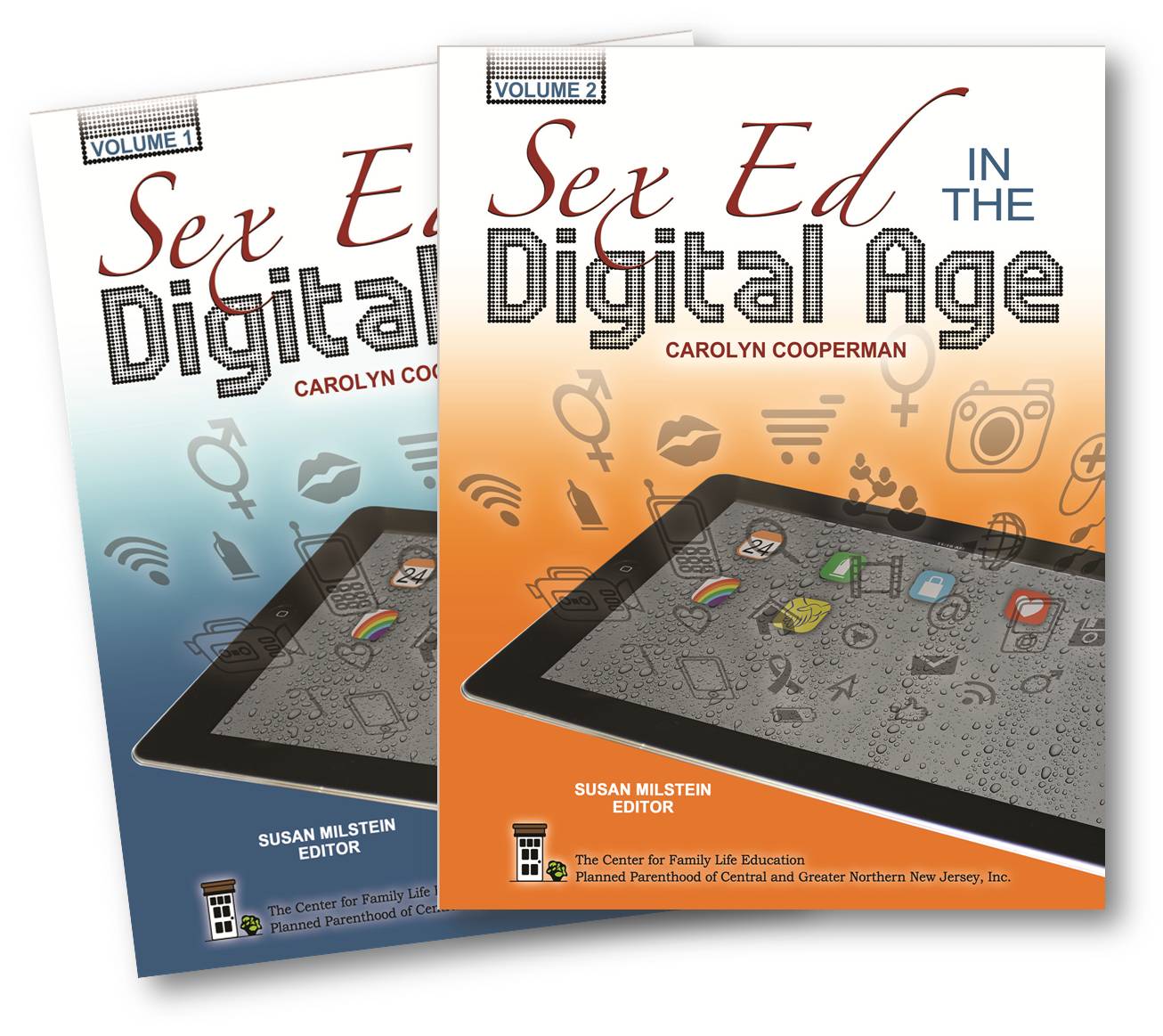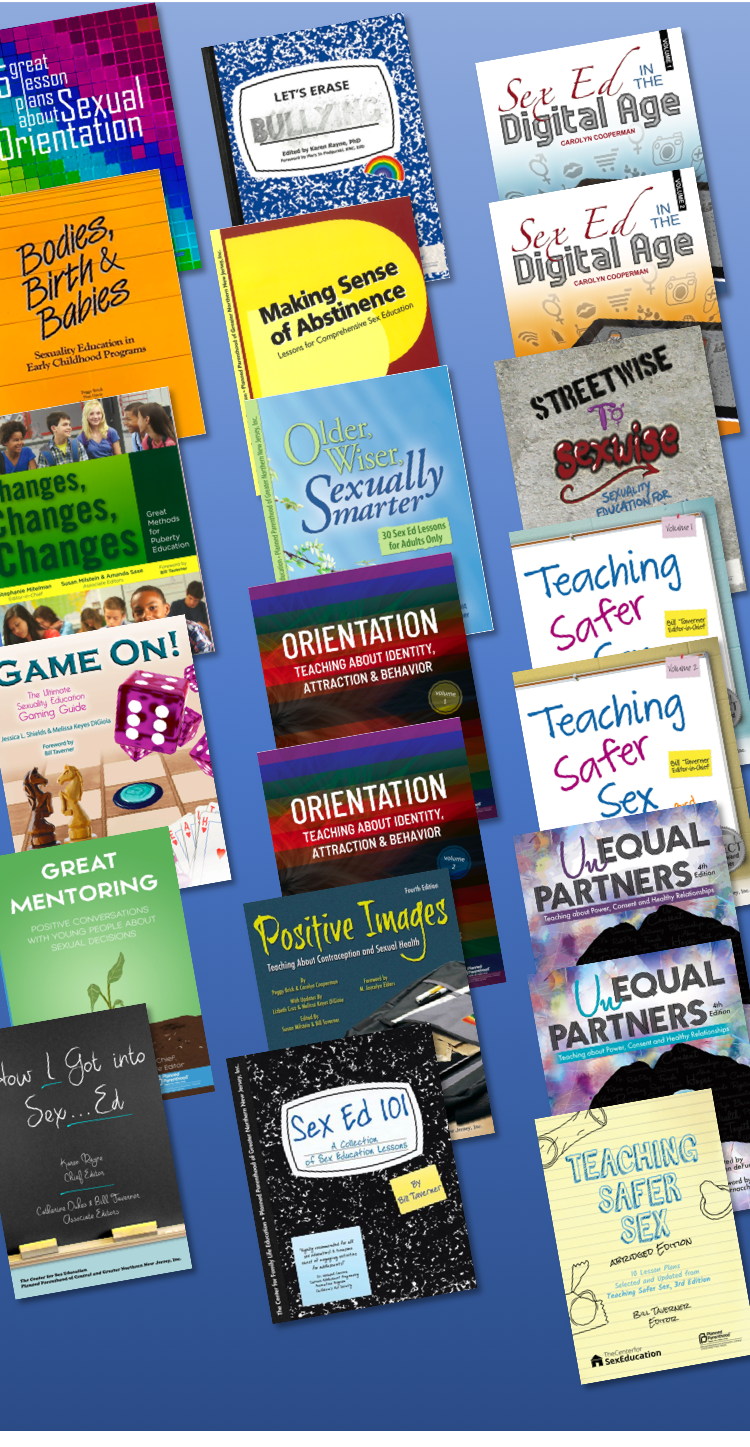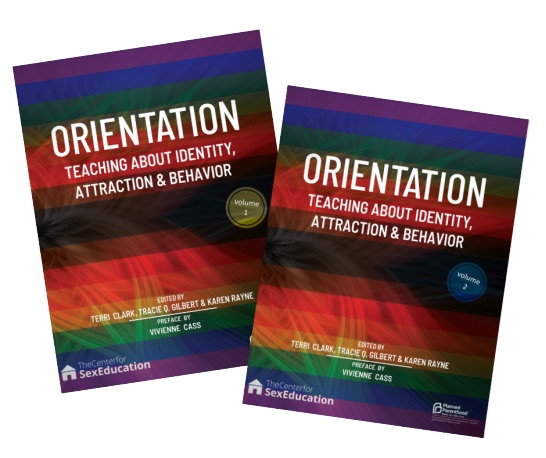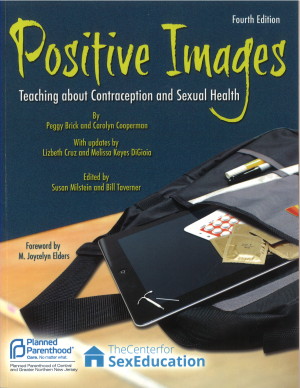Sex Ed in the Digital Age $99

A new manual for addressing modern challenges in teaching sexuality education.
Introduction to Sex Ed in the Digital Age
By Carolyn Cooperman, MA, MSW
Sex Ed in the Digital Age was two years in the making. The initial impetus for this project began with an observation that will not come as a surprise to those of us who work in the field of sex education-teenagers are as interested in technology as they are in sex. By linking the two, it then becomes possible to tap into an integral part of the adolescent experience. The opportunity to work with young people and explore subject matter that reaches into the core of their development is an exciting prospect for educators.
Today’s adolescents have unprecedented access to sexual information. This is a profound change for this generation of teenagers. On their own, without having to wait for parents to purchase books or schools to offer programs, they are bringing their sex-related questions, concerns, interests, and hormone-driven needs into the technological arena. Modern technology has undone centuries of secrecy surrounding sex. Now it is up to the parents and educators who care about fostering healthy sexual development to bring clarity and purpose to the technological advancements.
Sex Ed in the Digital Age includes structured lesson plans designed to equip educators and parents with skills that are necessary for meeting the challenges of the digital age. The principle objectives of the lesson plans are to help teens become more discriminating about electronic use; to know how to locate accurate information; and to better understand the impact that electronic communications have on self and others.
We are most grateful to sex educators from around the country who wrote lesson plans for these volumes. Working in middle schools, high schools, colleges and community-based programs, they have a handle on what teenagers are learning about sex from the countless hours they spend texting and browsing. Our common goal has been to help adolescents evaluate the appropriateness of their own electronic use.
Bill Taverner, MA, Executive Director of the Center for Sex Education, played a crucial role in bringing these volumes to fruition. He believed in this project from the outset, contributed original lesson plans, and set the administrative wheels in motion to make it happen. The editor, Sue Milstein, Ph.D, significantly enhanced the substance and form of this work. Her attention to detail, background in sex education, and experience in the classroom is truly valued.
Section 1
Getting Started: Introducing Teens to Sex Education in the Digital Age
Linking Sex And Technology
By Carolyn Cooperman, MA, MSW
The initial focus of this lesson broadens awareness of how human sexuality involves far more than sexual behavior. The participants then get to analyze sexual messages that can be found on social networking sites and the Internet. Their task is to begin to distinguish between the types of messages that promote well-being and those that do not.
Mindfulness Matters: Acting Purposefully In A Digital World
By Lee Heerten, MSW
This lesson moves beyond the standard, fear-based, “just say no” approach to problematic digital interactions and offers a more holistic and respectful alternative. This lesson addresses possible motivations behind the problematic behavior, affirms the real and complex needs of youth, and provides alternative behaviors to help youth fulfill those needs, both online and off.
Digital Footprints
By Carolyn Cooperman, MA, MSW
In this lesson, the individual digital footprint of each participant becomes more concrete, allowing for observation and personal reflection. By stepping back from the technological frenzy that consumes so much of daily life today, it then becomes possible to gain perspective about how technology use sheds light on values, interests, relationships and behaviors.
Passive Media Vs. Social Media
By Karen Rayne, PhD
Social media includes platforms that allow for technology-based interactions between two or more people. Passive media includes content that is designed to be looked at, listened to, or both, by a consumer. This lesson offers participants a chance to have a focused discussion about media types and how sexuality is incorporated.
Sexuality And Social Networking: What’s The Connection?
By Carolyn Cooperman, MA, MSW
This lesson begins with an open-ended exercise designed to elicit participant perceptions about online social networks. The views they express provide a window into their judgments, concerns and changing practices. The small-group exercise that follows allows for an in-depth investigation of how sexuality and social networking are interrelated.
Section 2
Staying Healthy: Using Technology To Access Information
Raising Questions, Finding Answers
By Carolyn Cooperman, MA, MSW
The primary objective of this lesson is to develop increased comfort and skill in using the Internet constructively. Online research in the classroom, under the supervision of an educator, can work to promote the acquisition of useful, preventative information. As the Internet has broadened educational outlets in unimaginable ways, so too can sexual health be enhanced by this medium.
Wiki Sex Ed
By Bill Taverner, MA, CSE
Wikipedia has become a source of routine information, and its interactive nature makes it ripe for critical examination by students. In this lesson, students will evaluate a Wikipedia page about a given sexual health topic and make necessary edits for improving it.
The Resource Adventure: Navigating Your Way Through The World Wide Web
By Jessica Shields, CHES® and Ashley Gaunt
How does a person find a reliable, reputable and knowledgeable source, especially when it comes to sexual health? In this interactive Internet scavenger hunt, participants will learn to navigate the Web for reliable sources.
Sex Ed, Siriously
By Bill Taverner, MA, CSE
This lesson will allow participants to evaluate the reliability of questions that might be asked of smartphones’ intelligent personal assistants, and check the results against Scarleteen and Sex, Etc., two reliable sexual information websites for teens.
Youtube And You
By Bill Taverner, MA, CSE
Especially popular among young people, YouTube presents a wonderful opportunity to “meet young people where they are” and engage them with a familiar medium. In this lesson, participants will watch sample videos, make storyboards for their own videos promoting sexual health, and create these videos.
Section 3
For Better Or Worse? How Technology Affects Relationships
Relating: Online Vs. In-Person
By Carolyn Cooperman, MA, MSW
In this lesson, participants get to try out both digital and direct modes of interaction, and evaluate the experience in terms of comfort level, sense of connection to others and preferences.
Telling The Whole Story: What Social Networking Pictures Often Leave Out
By Carolyn Cooperman, MA, MSW
This lesson provides the opportunity for participants to delineate the real-life emotions and problems typically encountered in social situations. They are asked to create a slide show that realistically portrays aspects of social interactions that are problematic and offer strategies for coping effectively.
As Seen On TV: Using Famous Couples To Evaluate Relationships
By Ashley Gaunt, Rebecca Roberts, MEd, CHES® and Jessica Shields, CHES®
Using the “Teen Power and Control Wheel” and examples of relationships from the media, this lesson will help participants to deconstruct media messages about what relationship characteristics are healthy or unhealthy.
Behind The Music: Music Literacy And Healthy Relationships
By Bill Taverner, MA, CSE
This lesson provides an opportunity for educators to help students to critically examine the messages they are hearing in the music that surrounds them, and to think about how they might infuse the qualities of a healthy relationship into the lyrics of their favorite songs.
Staying Cool Under (Peer) Pressure: Using Digital Education Tools To Model Assertive Communication Skills
By Jessica Silk, MPH
The digital tool “The Kickback” is designed to allow young people to see what happens when passive, assertive or aggressive communication is used. Participants will leave the lesson with new resources they can use on their phones or computers to further their learning.
Section 4
Creating Safe, Inclusive Programs
Googling Human Rights
By Carolyn Cooperman, MA, MSW
In this lesson, participants will use their online skills to relate to the ways in which life improves when rights that were once denied are ultimately granted. Participants begin to understand that as in all human rights struggles, progress is made through activism, legislation and support from the broader population.
E-Flirting: Looking At Gender, Sexual Orientation, Risk, And More
By Carolyn Cooperman, MA, MSW
It is important that teens have some criteria to use when navigating the social landscape and forming relationships online. This lesson will allow all participants to explore the topic of e-flirting personally, without the predominant emphasis placed on heterosexual flirting.
Engaging Generation Z In Peer-Driven Advocacy: Promoting An Inclusive School Environment For LGBTQ Youth Through Project-Based Learning
By Hannah M. Priest, CHES®, MAED, Christine L. Hackman, MA and Sarah E. Rush, MA
Project-based learning is a student-centered instructional technique that requires students to think critically, problem solve and collaborate. By utilizing accessible technology, students will work in groups to develop and implement a creative strategy that will be used to promote an inclusive school environment for LGBTQ students.
Rallying Against Bullying
By Carolyn Cooperman, MA, MSW
To address teenage uncertainty about what to do when damaging texts, photos or postings circulate, this lesson challenges participants to use their skills in technology, music, art, writing, drama, etc. to lead a peer-initiated response to cyberbullying. Participants develop projects that demonstrate how prevention, intervention and support can all be employed to counter the damaging effects of online bullying.
Section 5
Privacy, Consent, And Safety
If It’s Private, Don’t Post It
By Carolyn Cooperman, MA, MSW
This lesson demonstrates how well-intended measures to safeguard privacy can fail, resulting in potential embarrassment, harassment and review by colleges and future employers. The take-away message is clear: the safest way to protect private information is to refrain from posting it in the first place.
You Can’t Get It Back
By Margo DeNuccio and Meghan Benson, MPH, CHES®
In recent years, there have been many media stories about teens and young adults (and adults) who have sent and posted pictures, videos and other content and later regretted doing so. This lesson helps participants identify why it is difficult to remove something once it has been posted, and factors to consider before testing or posting something online.
Text Then Sext: What Happens Next?
By Rebecca Roberts, MEd, CHES® and Catherine Dukes, PhD
With an emphasis on sexting, cellphone use and the Internet, this lesson will allow participants to discover the myths and facts about sexually explicit media through an interactive game and case studies. Small-group processing will assist students in exploring these topics in greater depth, while enhancing decision-making skills and reflecting on personal beliefs and values.
Think Before You Text
By Carolyn Cooperman, MA, MSW
This lesson uses some very basic principles in neuroscience and applies them to decision-making about sexting. As the participants explore real-life dilemmas related to sexting, they gain a clearer understanding of the dynamics involved.
Safer Cyber Sex: Exploring Online Relationships
By Jessica Shields, CHES®
With the Internet as a dominant resource, it is important to take precautions against intrusions and fraud, including those that involve relationships. The purpose of this lesson is to help young adults feel more comfortable using the Internet responsibly to form relationships and access sexuality information.
Section 6
Critical Decision-Making In A Changing World
Porn, Porn, Everywhere! A Values Clarification Lesson Plan For Young Adults
By Kirsten deFur, MPH
This lesson will explore the many values that people hold regarding pornography, offer an opportunity for participants to evaluate their own values, and outline important factors to consider when making decisions about whether or not to consume pornography.
Online Pornography In The Digital Age
By Carolyn Cooperman, MA, MSW
Despite the increased availability and exposure to online pornography, corresponding opportunities for constructive discussions about this medium are unfortunately non-existent for most teens. This lesson will help participants make distinctions between the fantasies portrayed in pornography and the emotional and health-related realities confronted in actual relationships.
What Was I Thinking?
By Carolyn Cooperman, MA, MSW
This lesson uses some very basic principles in neuroscience and applies them to decision-making about sexting. As the participants explore real-life dilemmas related to sexting, they gain a clearer understanding of the dynamics involved.
Decisions About Sexting
By Carolyn Cooperman, MA, MSW
The exercises about sexting that are used in this lesson are meant to be fun and engaging, but they also challenge participants to identify personal beliefs, share thoughts with peers, raise uncertainties and clarify facts. Skills for defending beliefs and negotiating conflicts are practiced by working in small groups and participating in a role-play.
Section 7
Preparing Sex Educators and Parents for the Digital Age
Technology And Teenage Sexuality: A Lesson For Parents
By Carolyn Cooperman, MA, MSW
This lesson tries to strike a balance between addressing the legitimate safety concerns that parents have about technology, while offering them an introduction into the types of technological resources that can actually benefit teenagers. Integrated throughout are opportunities for parents to consult with one another as they strive to define technological parameters in a rapidly changing world.
Helping Teens Act Purposefully In A Digital World: A Lesson For Parents And Professionals
By Lee Heerten, MSW
This lesson encourages caring adults to recognize the possible motivations behind young people’s problematic digital interactions, affirm the real and complex needs of youth, and assist young people in finding healthier ways to fulfill their needs, both online and off.
A 21st Century Conversation Guide To Teenage Sexuality And Technology: A Lesson For Adults
By Shanna M. Dusablon Drone, MSW, MAEd, MEd
Adult caregivers are key stakeholders in guiding adolescents into learning decision-making skills about sexual communication through various social media. This lesson aims to empower adults as well as increase their comfort levels regarding communication skills in reference to adolescent sexuality and technology.
Both volumes include the following materials:
Principles for sex education
Creating a supportive environment for learning about sexual health
How to use Sex Ed in the Digital Age
How to use role-play
Summary information about:
- Apps
- Clickers
- Controlling your privacy on Facebook
- Snapchat
- Tumblr
“Sex Ed in the Digital Age is a tremendous addition to the pantheon of CFLE curricula. There are lessons on sexting, pornography, and social media, on evaluating sexuality information found on websites for accuracy and authority, and creating technology-based resources to prevent bullying and promote inclusivity in classrooms. There are some great lessons that address the concerns of parents and other professionals. The table of contents alone provides a comprehensive guide to what needs to be covered when addressing this increasingly essential topic, and the lessons within provide expert guidance for addressing them with honesty, openness, and accuracy.”
Megara Bell & Brian Flaherty
Partners in Sex Education
“I think this is FANTASTIC. It is fantastic media literacy education, fantastic sex education, and an incredible blend of both. I love how well it addresses technology and media critically, but without panic or scare tactics. Nothing in here comes across as adultist to me, which is quite a coup when addressing both sex and technology for young people, two areas where people err with adultism all the time. The approach here seems very teen-friendly, and has a relaxed approach to technology, sex and media I think young people will really resonate with and appreciate. The resounding message to me here is that none of these things are bad, or even necessarily problematic, but that how you use them, what you know about them and how much weight you give them is most of what is going to make experiences with them positive or negative.”
Heather Corinna
Founder, Scarleteen
“Sex Ed in the Digital Age introduces, guides and updates sex educators, teenagers and parents for the digital age. This is the first modern resource that provides comprehensive link between new technology and sexuality education. Finally sexuality educators can plunge into the world where teenagers live daily. Authors and contributors of this manual earn special honor of this excellent achievement.”
Prof. Osmo Kontula
Chair of Sexuality Education Committee
World Association for Sexual Health
“Sex Ed in the Digital Age is an educational tool that is long overdue in the world of today’s teenagers. The lesson plans are carefully crafted and easy to follow. This book also works well to help sexuality educators design courses that are intellectually and developmentally sound and exciting for the students. I heartily recommend this book to educators who are willing to move forward in their educational structure.”
Elizabeth Mooney, DArts
Retired Research Associate, Kinsey Institute
“For young people in the Internet Age, questions of what’s acceptable, what’s publicly acknowledged, what’s socially the norm when it comes to sexual behavior, are changing. A new approach to sex education in the Internet Age is required to reflect and respond to the changing knowledge, exposure and attitudes of young people toward sex. Sex Ed in the Digital Age offers educators, parents and administrators an important guide for educating increasingly sophisticated and sexually advanced students.”
Jack Myers
Author of Hooked Up: A New Generation’s Surprising Take on Sex, Politics, and Saving the World
“Millennials are digital natives who are diverse, tech savvy, and open-minded to innovative ideas. Sex Ed in the Digital Age brings together youth development strategies, promotes best practices that integrate sexual health and rights information, and offers young people’s experiences as a valuable contribution. This tool will give sex educators and families the facts and skills to provide young people with information they need to protect their health and futures.”
Trina Scott
Founder, Women of Color Sexual Health Network
“Sex Ed in the Digital Age is a teaching manual, charting unexplored waters. My education staff and I love it!”
Cory Neering
Vice President of Education with Planned Parenthood of South Florida & the Treasure Coast
“This book will be a highly valuable contribution to any sex education curriculum, and will benefit a population which is both deserving of and in need of the awareness and information it provides with regard to sexuality and relationships in the age of technology. Excellent!!”
Amy G. Settele, B.S., M.A.
Youth Transitional Services Specialist & Mother/Step Mother of six teenagers
Download a free sample lesson plan here.
Special requests?
We can accomodate! For bulk orders or paying by purchase order, please click below to get in touch:



